Oldsmobile Aurora 1998 Owner's Manuals
Manufacturer: OLDSMOBILE, Model Year: 1998, Model line: Aurora, Model: Oldsmobile Aurora 1998Pages: 380, PDF Size: 19.75 MB
Page 291 of 380

2.
3.
Unscrew the
convenience net
attachment nut. Open
the trim panel door.
Remove the two wing
nuts now exposed.
4. Remove the taillamp filler screw located to the side
of the taillamp filler panel.
6-39
Page 292 of 380
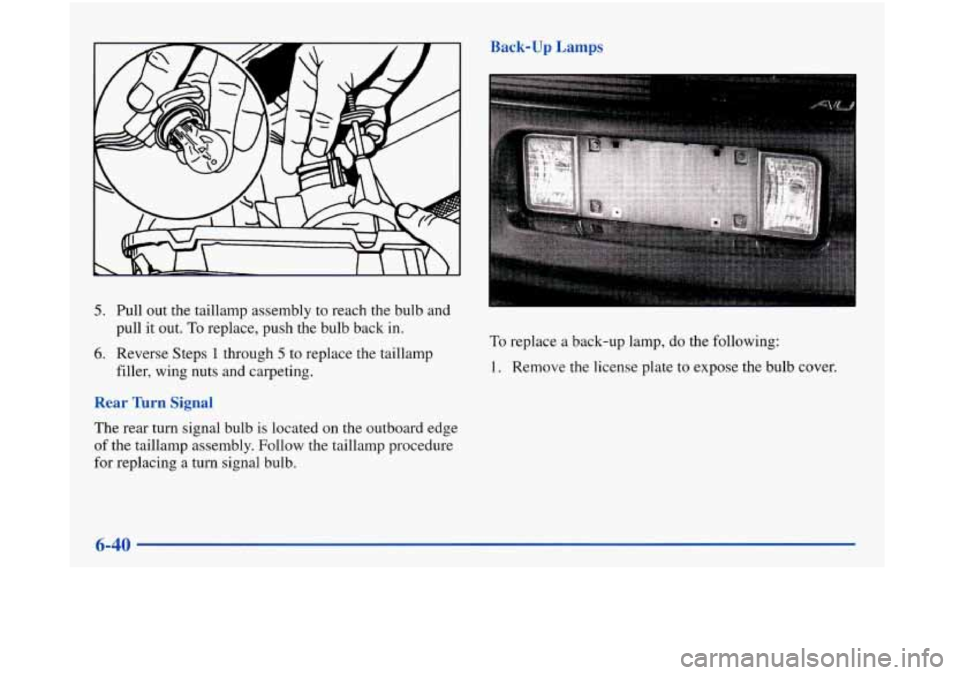
Back-up Lamps
5. Pull out the taillamp assembly to reach the bulb and
pull it out.
To replace, push the bulb back in.
6. Reverse Steps 1 through 5 to replace the taillamp
filler, wing nuts and carpeting.
Rear lhrn Signal
The rear turn signal bulb is located on the outboard edge
of the taillamp assembly. Follow the taillamp procedure
for replacing a turn signal bulb.
To replace a back-up lamp, do the following:
1. Remove the license plate to expose the bulb cover.
6-40
Page 293 of 380
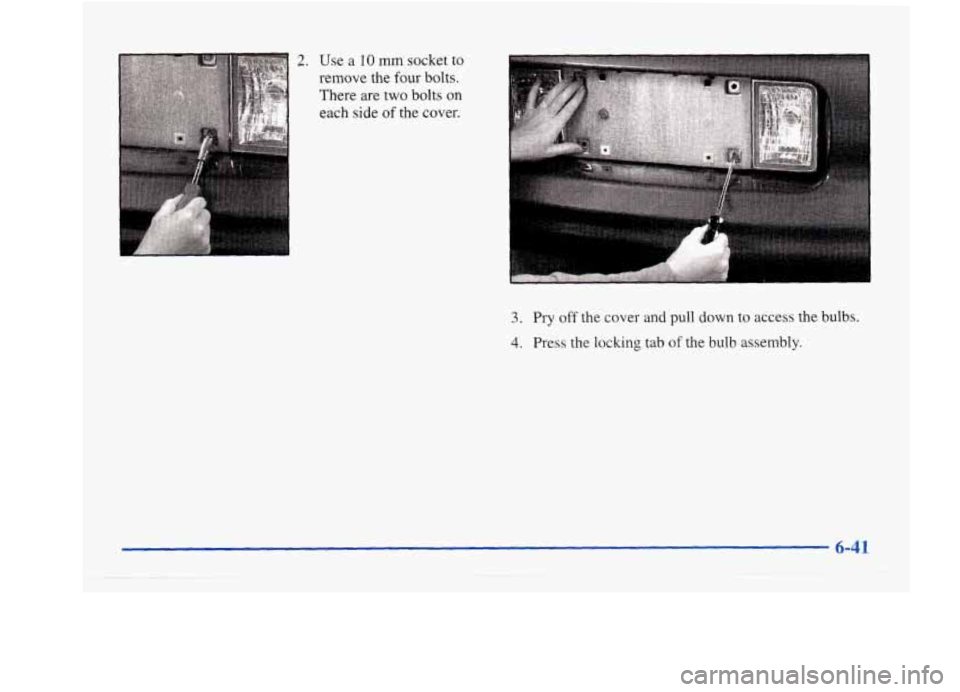
2. Use a 10 mm socket to
remove the four bolts.
There are two
bolts on
each side of the cover.
3. Pry off the cover and pull down to access the bulbs.
4. Press the locking tab of the bulb assembly.
6-41
Page 294 of 380

5. Twist the socket one-quarter of a turn to the left
(counterclockwise) and pull to remove.
6. Replace the bulb and reverse Steps 1 through 4 to
replace the assembly and tighten the bolts.
Interior Lamps
Front and Rear Reading Lamps
To change the bulbs in the front and rear reading lamps,
do the following:
1. Carefully insert a flat head screwdriver in the slot
2. Gently pry the lens cover away to expose the reading
3. Remove the bulb from its assembly and install a
between the lens
cover and molding.
lamp bulb. The lens cover should
pop off.
new bulb.
4. Snap the lens cover back in place.
6-42
Page 295 of 380
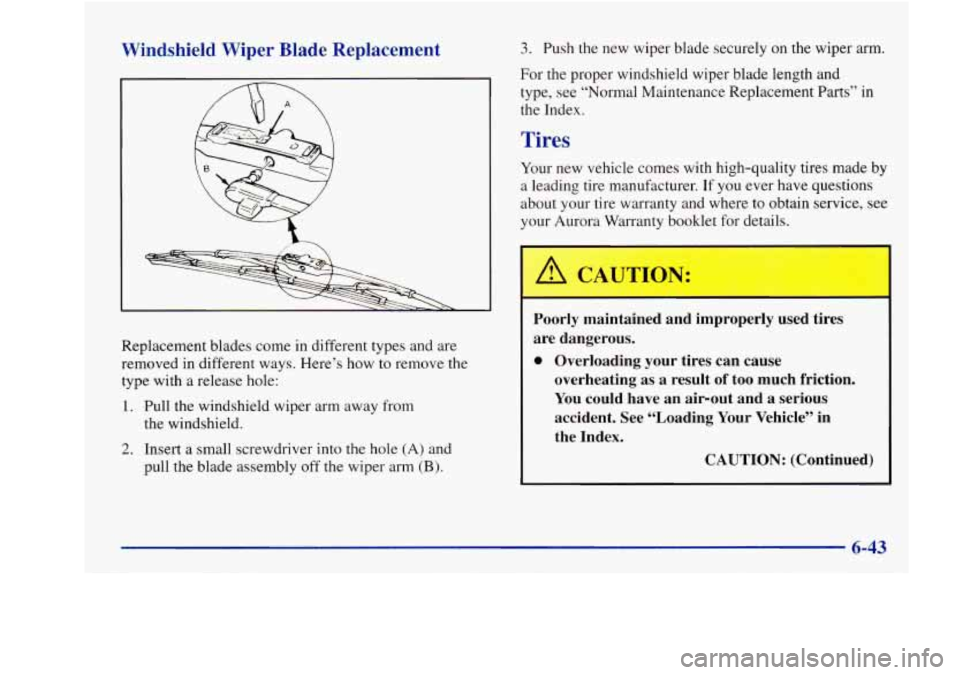
Windshield Wiper Blade Replacement
Replacement blades come in different types and are
removed in different ways. Here’s how
to remove the
type with a release hole:
1. Pull the windshield wiper arm away from
the windshield.
2. Insert a small screwdriver into the hole (A) and
pull the blade assembly
off the wiper arm (B).
3. Push the new wiper blade securely on the wiper arm.
For the proper windshield wiper blade length and
type, see “Normal Maintenance Replacement Parts” in
the Index.
Tires
Your new vehicle comes with high-quality tires made by
a leading tire manufacturer. If you ever have questions
about your tire warranty and where to obtain service, see
your Aurora Warranty booklet
for details.
Poorly maintained and improperly used tires
are dangerous.
0 Overloading your tires can cause
overheating as a result of
too much friction.
You could have an air-out and a serious
accident. See “Loading Your Vehicle” in
the Index.
CAUTION: (Continued)
Page 296 of 380

I
I
0
0
0
Underinflated tires pose the same danger as
overloaded tires. The resulting accident
could cause serious injury. Check all tires
frequently to maintain the recommended
pressure. Tire pressure should be checked
when your tires are cold.
Overinflated tires are more likely to be
cut, punctured or broken by
a sudden
impact
-- such as when you hit a pothole.
Keep tires at the recommended pressure.
Worn, old tires can cause accidents.
If your
tread is badly worn, or
if your tires have
been damaged, replace them.
I
Inflation -- Tire Pressure
The Tire-Loading Information label, which is on the
rear edge of the driver’s
door, shows the correct
inflation pressures for your tires when they’re cold.
“Cold”
means your vehicle has been sitting for at least
three hours
or driven no more than 1 mile (1.6 km).
NOTICE:
Don’t let anyone tell you that underinflation or
overinflation
is all right. It’s not. If your tires
don’t have enough
air (underinflation), you can
get the following:
Too much flexing
Too much heat
0 Tire overloading
Bad wear
0 Bad handling
Bad fuel economy.
If your tires have too much air (overinflation),
you can get the following:
Unusual wear
Bad handling
Rough ride
Needless damage from road hazards.
6-44
!
Page 297 of 380

When to Check
Check your tires once a month or more.
Don’t forget your compact spare tire. It should be at
60 psi (420 Wa).
How to Check
Use a good quality pocket-type gage to check tire
pressure. You can’t tell if your tires are properly inflated
simply by looking at them. Radial tires may look
properly inflated even when they’re underinflated.
Be sure to put the valve caps back on the valve stems.
They help prevent leaks by keeping out dirt and moisture.
Tire Inspection and Rotation
Tires should be rotated every 6,000 to 8,000 miles
(10 000 to 13 000 km). Any time you notice unusual
wear, rotate your tires as soon as possible and check
wheel alignment. Also check for damaged tires or wheels.
See “When It’s Time for New Tires” and
“Wheel
Replacement” later in this section for more information.
The purpose
of regular rotation is to achieve more
uniform wear for all tires on the vehicle. The first
rotation is the most important. See “Scheduled
Maintenance Services” in the Index for scheduled
rotation intervals. When
rotating your tires, always use the correct
rotation pattern shown here.
Don’t include the compact spare tire in your
tire rotation.
After the tires have been rotated, adjust the front and
rear inflation pressures as shown
on the Tire-Loading
Information label. Make certain that all wheel nuts
are properly tightened. See “Wheel Nut Torque” in
the Index.
Page 298 of 380
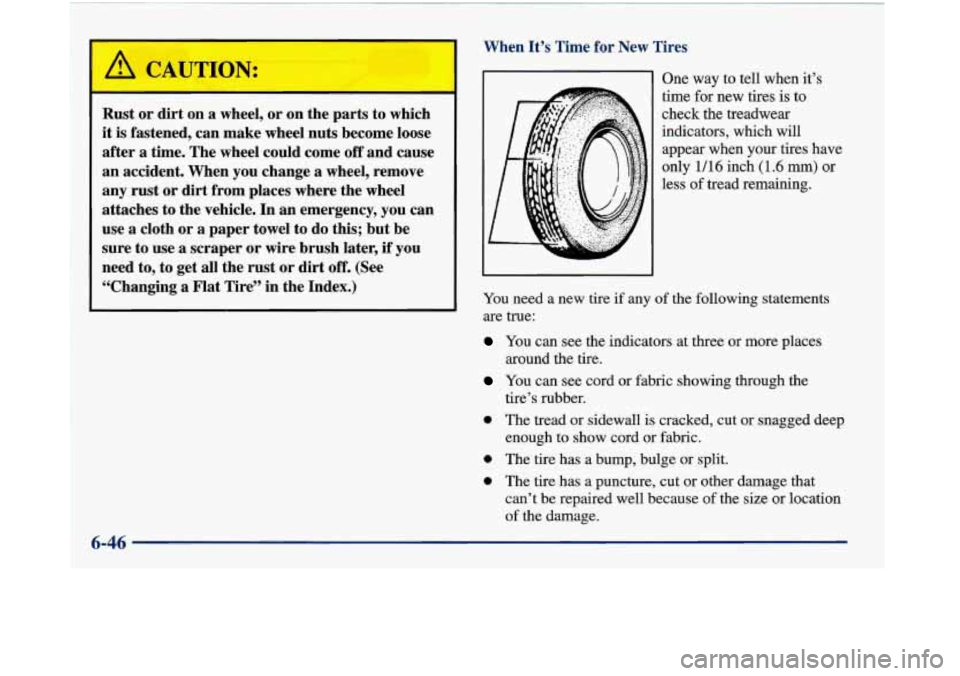
When It’s Time for New Tires
-
Rust or dirt on a wheel, or on the parts to which
it is fastened, can make wheel nuts become loose
after
a time. The wheel could come off and cause
an accident. When you change a wheel, remove
any rust or
dirt from places where the wheel
attaches to the vehicle. In an emergency, you can
use a cloth or a paper towel to
do this; but be
sure to use a scraper or wire brush later,
if you
need to, to get all the rust or dirt
off. (See
“Changing a
Flat Tire” in the Index.)
One way to tell when it’s
time for new tires is to
check the treadwear
indicators, which will
appear when your tires have
only
1/16 inch (1.6 mm) or
less of tread remaining.
You need a new tire if any of the following statements
are true:
You can see the indicators at three or more places
You can see cord or fabric showing through the
around
the tire.
tire’s rubber.
e The tread or sidewall is cracked, cut or snagged deep
enough to show cord or fabric.
e The tire has a bump, bulge or split.
e The tire has a puncture, cut or other damage that
can’t be repaired well because of the size or location
of the damage.
6-46
Page 299 of 380
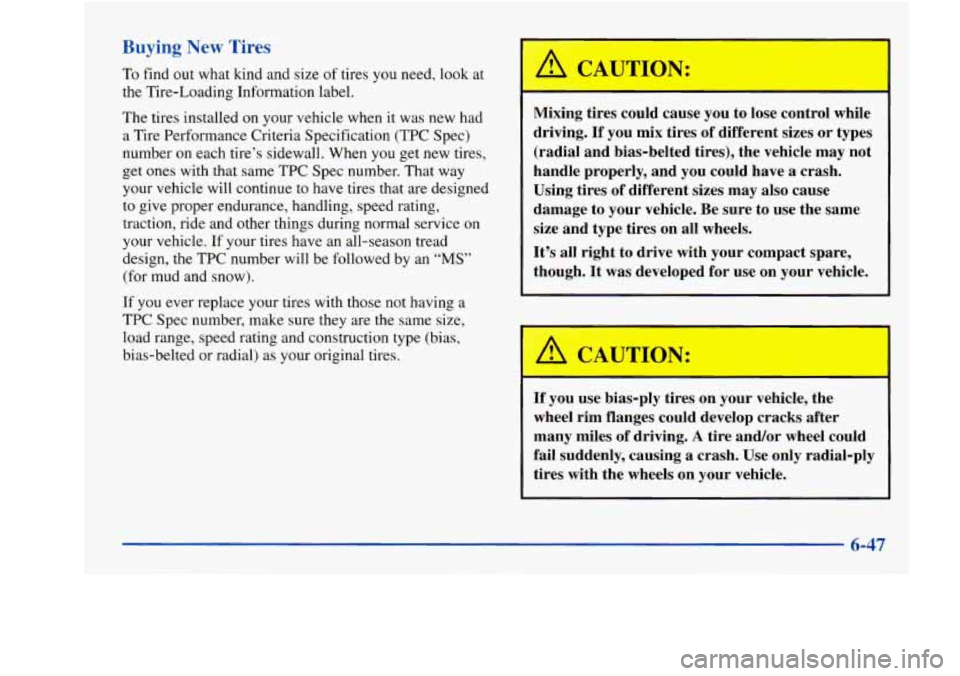
Buying New Tires
To find out what kind and size of tires you need, look at
the Tire-Loading Information label.
The tires installed on your vehicle when it was new had
a Tire Performance Criteria Specification (TPC Spec)
number on each tire’s sidewall. When you get new tires,
get ones with that same TPC Spec number. That way
your vehicle will continue to have tires that are designed
to give proper endurance, handling, speed rating,
traction, ride and other things during normal service
on
your vehicle. If your tires have an all-season tread
design, the
TPC number will be followed by an “MS”
(for mud and snow).
If you ever replace your tires with those not having a
TPC Spec number, make sure they are the same size,
load range, speed rating and construction type (bias,
bias-belted or radial) as your original tires. Mixing tires could cause
you to
lose control while
driving.
If you mix tires of different sizes or types
(radial and bias-belted tires), the vehicle may not
handle properly, and you could have
a crash.
Using tires of different sizes may also cause
damage to your vehicle. Be sure to use the same
size and type tires on all wheels.
It’s all right to drive with your compact spare,
though. It was developed for use on your vehicle.
If you use bias-ply tires on your vehicle, the
wheel rim flanges could develop cracks after
many miles of driving.
A tire and/or wheel could
fail suddenly, causing a crash. Use only radial-ply
tires with the wheels on your vehicle.
6-47
Page 300 of 380
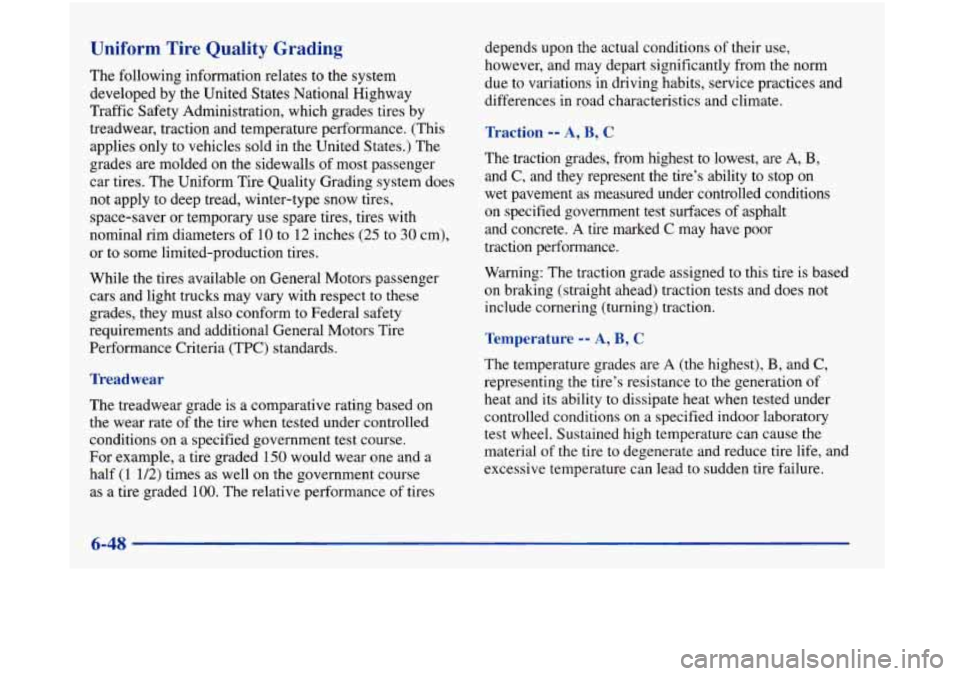
Uniform Tire Quality Grading
The following information relates to the system
developed
by the United States National Highway
Traffic Safety Administration, which grades tires by
treadwear, traction and temperature performance. (This applies only to vehicles sold in the United States.) The
grades are molded on the sidewalls of most passenger
car tires. The Uniform Tire Quality Grading system does
not apply to deep tread, winter-type snow tires,
space-saver or temporary use spare tires, tires with
nominal rim diameters of 10 to 12 inches (25 to
30 cm),
or to some limited-production tires.
While the tires available on General Motors passenger
cars and light trucks may vary with respect to these
grades, they must also conform to Federal safety
requirements and additional General Motors Tire
Performance Criteria (TPC) standards.
Treadwear
The treadwear grade is a comparative rating based on
the wear rate
of the tire when tested under controlled
conditions on a specified government test course.
For example, a tire graded
150 would wear one and a
half (1 1/2) times as well on the government course
as a tire graded 100. The relative performance of tires depends upon
the actual conditions of their use,
however, and may depart significantly from the norm
due to variations in driving habits, service practices and
differences in road characteristics and climate.
Traction -- A, B, C
The traction grades, from highest to lowest, are A, B,
and C, and they represent the tire’s ability to stop on
wet pavement as measured under controlled conditions
on specified government test surfaces
of asphalt
and concrete.
A tire marked C may have poor
traction performance.
Warning: The traction grade assigned to this tire is based
on braking (straight ahead) traction tests and does not
include cornering (turning) traction.
Temperature -- A, B, C
The temperature grades are A (the highest), B, and C,
representing the tire’s resistance to the generation of
heat and its ability
to dissipate heat when tested under
controlled conditions on a specified indoor laboratory
test wheel. Sustained high temperature can cause the
material of the tire to degenerate and reduce tire life, and
excessive temperature can lead to sudden tire failure.
6-48